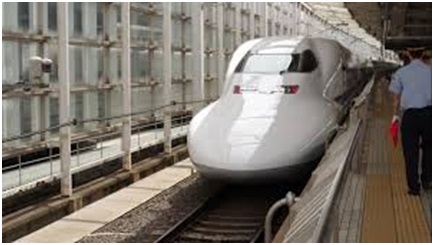The officials have confirmed that India along with Japan are working together to customize and make key technical changes to the bullet train that is expected to run between Mumbai and Ahmedabad from 2023 so that the train can withstand the extreme heat and high pollution levels of India
The National High-Speed Rail Corporation (NHSRCL), which is executing the project linking the capitals of Maharashtra and Gujarat, believes the trains will have to be customised for Indian conditions so that they don’t break down due to heat and dust.
According to Achal Khare, Managing Director of NHSRCL, the train that runs in Japan has a capacity of handling 35 degrees Celsius of temperature. But the section that the train is to run in Maharashtra, the outside temperature can rise to 50 degrees. Hence some modifications are mandatory.
The spokesperson for NHSRCL, Sushma Gaur said that keeping in mind the environmental conditions in India, the dust filters will be installed in the air conditioners, blowers, and other important equipment fitted in the high-speed trains. These filters will be like a fine mesh as commonly used in air-conditioning units and will serve as a barrier from the dust entering inside the trains which will help further in maintaining the ambient air quality inside the trains. They will also safeguard the equipment from harmful dust mites and other pollutants
India’s first bullet train which is also known as Shinkansen in Japan will lead India’s shift to an era of high-speed trains which is also capable of hitting a speed of up to 350km per hour. The air conditioning system in these bullet trains is fitted inside the body of the coaches unlike the ones in a Metro system and therefore it is not exposed to the outside environment.
Khare also confirmed that these trains will have pressurized cabins similar to that of an aircraft. At the beginning, India is expecting to have a 24 train sets out of which 18 will come from Japan and 6 will be manufactured in India. But the ones manufactured in India will not be 100% manufactured here since few of the critical parts will still come from Japan.
Extra luggage space for the passengers will also be provided in these bullet trains. Every coach is expected to have overhead space for hand baggage while the last coach will have some seats removed to make space for the extra check-in luggage, for which the passengers need to pay extra- the first for a train in India.
The Narendra Modi government has set an ambitious deadline for completing the project by August 15, 2022, when India marks 75 years of Independence. NHSRCL expects to open one portion of the network by then and complete the entire Mumbai-Ahmedabad stretch by December 2023.
Of the 508.17km corridor, 155.76km will be in Maharashtra, 348.04 km in Gujarat and 4.3km in Dadra and Nagar Haveli. Only about 35 % of the land required for the project has been acquired so far.
The foundation stone for the Mumbai-Ahmedabad bullet train project was laid by Prime Minister Modi and his Japanese counterpart Shinzo Abe in 2017.

